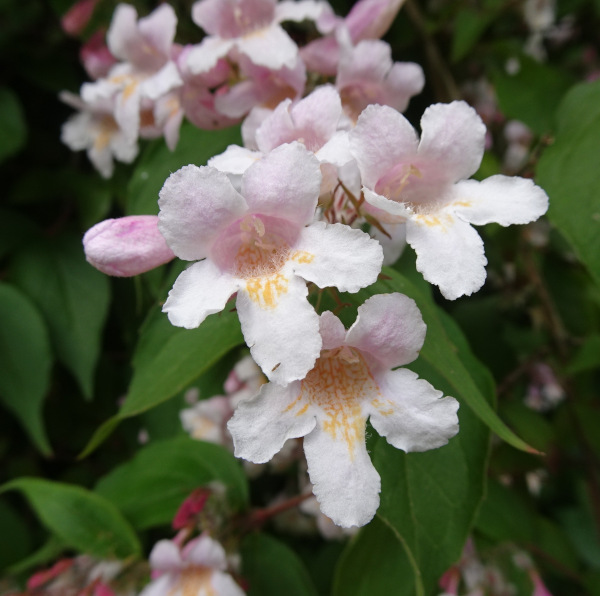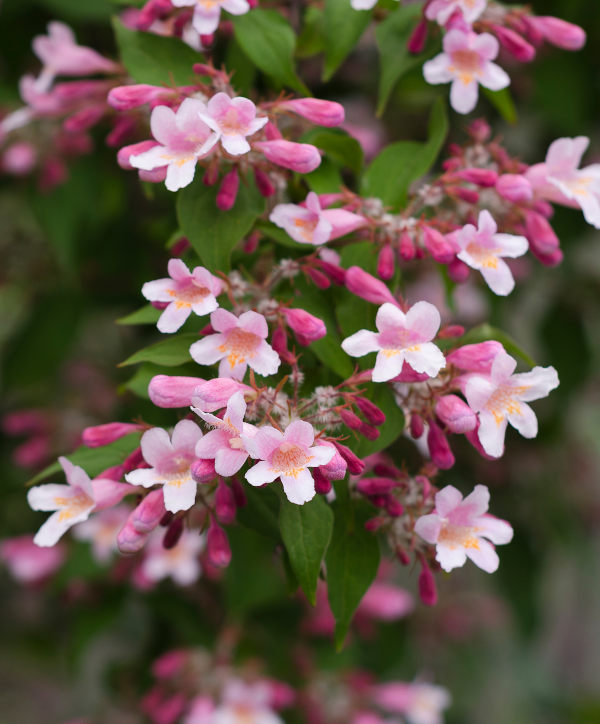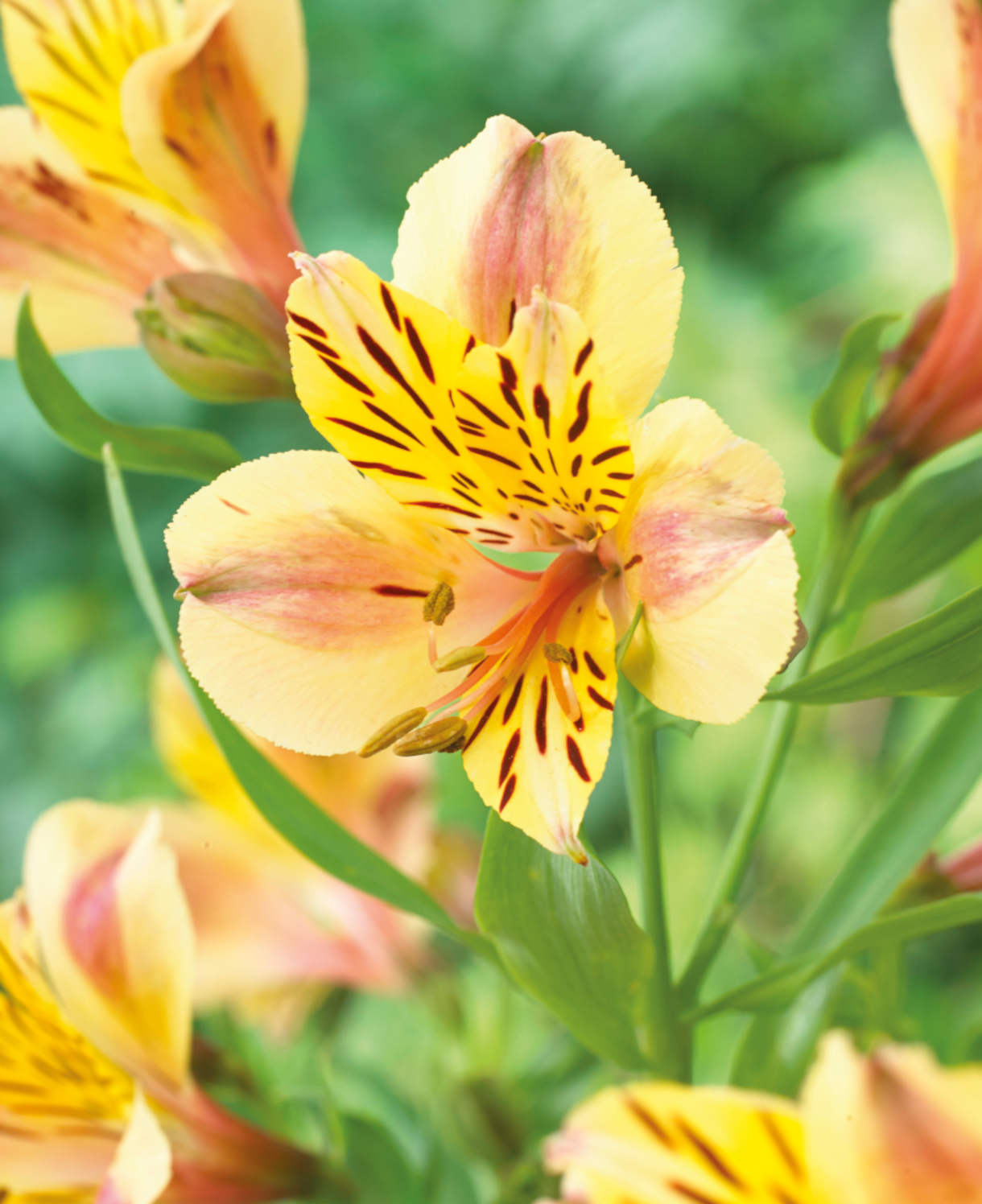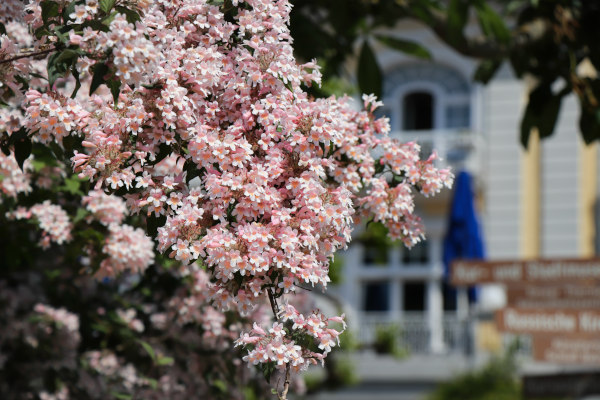How to grow Kolkwitzia
Within the family Caprifoliaceae, Kolkwitzia is a genus of only one species Kolkwitzia amabilis.
The family Caprifoliaceae contains the well-known shrubby climber, ‘Honeysuckle’ lonicera species.
Kolkwitzia is a deciduous, suckering, upright shrub originating from China, with arching stems of light brown flaky bark. Flowering in late spring and grown in pairs, dark pink buds open to reveal light pink petals and a yellow throat about 2.5cm long.
Commonly known as the ‘Beauty Bush’ it is an undervalued plant in the garden. Kolkwitzia is so floriferous its branches are weighed down by its flowers that form on wood grown the previous year.
With Awards of Garden Merit for many of its cultivars from the R.H.S. this species (and variety) was described by Paul Graebner (Berlin 1871 -1933) and named after fellow Berlin botanist Richard Kolkwitz (1873-1956). The species variety name, amabilis, means lovely in Latin.

Zantedeschia is a genus of flowering plants from the family Araceae and is native to southern Africa. With a rich history dating back to the Ancient Romans, these deciduous or semi-evergreen perennials have been used as a symbol of celebration. Zantedeschia was Named after Professor Giovanni Zantedeschia, an Italian botanist.
There are two main forms of Zantedeschia: hardy and tender. Hardy forms of the plant can be grown outdoors, enjoy moist soil and full sun or partially shaded conditions - these are known as Arum lilies. Tender forms of Zantedeschia prefer being grown in containers or pots and should be brought inside over the winter - these are known as Calla lilies.
With tuberous flora in all colours from whites, yellows and oranges to deep reds and purples, Zantedeschias are not to be overlooked in any garden, as long as they have sufficient sunlight to grow in.
Ready to learn more about growing Zantedeschia? Read on for all there is to know...

Key Information
Soil pH
Position
Hardiness


Where & when to plant Kolkwitzia
Position - Full sun or dappled shade, in any aspect on sheltered or exposed sites.
Soil - Moist well drained soil which is can be either chalk, clay, loam or sand with any pH.
Flower - Spring and summer.
Hardiness - H6 ( -15°C to -20°C)
Kolkwitzia can be planted all year around when purchased grown in pots, however can be more prone to rotting off if planted in late autumn and winter
If container grown plants are planted out during the active summer growing season make sure that they are watered regularly until the plant has settled into its new location. Water at soil level rather than the foliage.
Kolkwitzia are ideal in cottage garden schemes, and low maintenance borders.
How to plant Kolkwitzia
- For planting in the garden, dig the soil area removing any large stones and weeds and breaking up any lumps. Mix in some organic matter, ideally leaf mould, though manure or garden compost are also fine. Rake level and firm with your heels. Rake level again.
- Water plants well and allow to drain before planting.
- A good tip is to dig a hole twice the size of the root-ball. Fill with water and allow to drain before placing in the plant which is especially good for summer plantings.
- Remove the plant from its pot placing the plant in the hole, ensuring the top of the root ball sits level with the surface of the soil. Too low and the plant may rot, too high and the roots can dry out.
- Backfill with soil and firm in gently with your foot.
- Soak soil well with water.
- For planting in containers, first choose an appropriately sized pot around 5-7cm larger than the root ball of your plant (you’ll need to gradually increase the pot size every few years). Always ensure there are plenty of drainage holes in the bottom.
- Use a good quality potting compost if you have it and mix with garden soil. Mix in some horticultural grit and, if not already present (check the labelling on the bag) some slow-release fertiliser granules.
- Start by partially filling the pot with compost; enough so that when placed on it the upper surface of the root ball is about 3cm lower than the top of the pot.
- Fill around the plant with compost, firming down with your fingers then adding a little more so it is held tight.
- Pick up the container and lightly tap on the potting bench or ground a few times to help further settle the compost around the plant.
- Soak well with water.

What to plant with Kolkwitzia
Outdoors, plant alongside plants with different shaped or coloured foliage as a contrast whilst also making sure nearby plants have interest when kolkwitzia is not in flower.
Try Alstroemeria, Ceanothus, Clematis, Delphinium, Ferns and Grasses, Hardy Geranium, Roses, Pansy, Tulip, Narcissus (Daffodil) and Viburnum.



How to care for Kolkwitzia
Pruning and Deadheading
There’s no need to remove faded flowers as kolkwitzia are self-cleaning.
Kolkwitizia are easy care shrubs which fall into R.H.S Pruning Group 2.
Immediately after flowering, cut out any damaged or unwanted stems back to their point of origin or ground level. Where stems are crossing remove some to ground level to avoid congestion and open up the centre of the bush. Remove any weak or spindly twiggy shoots back to point of origin. Only keep the strongest looking stems so that the best flowers are produced next spring.
Finally cut back flowered stems to a strong shoot lower down so the plant looks balanced. Remove a few of the ageing stems right to the base.
Watering
Preferring moist yet, free drained sites which do not sit wet in winter.
On planting outside, they benefit from a good watering in on planting and then regular soakings until established. After this they should not need watering.
If grown in containers water the soil regularly checking the compost to see if the soil is dry when you wiggle your fingertip into the soil surface. Stand containers on pot feet to allow water to drain freely from the container in winter.
Feeding
On healthy, fertile soil, a mulch of well-rotted organic matter (i.e., a layer of leaf mould, manure, or garden compost applied to the soil around the plant) should provide enough nutrients for your kolkwitzia. This has the added benefit of suppressing weeds and locking in moisture. Mulch when planting, and then again each spring.
If you garden on poor soil or your kolkwitzia looks in need of a boost, applying a granular general purpose feed to the surface of the soil and lightly working in can reap benefits. This is known as a top dress and should be done when you’re mulching in spring – first apply the feed, then cover with the mulch.
Container-grown plants are different as they rely solely on the gardener for nutrition. Get off to a flying start by making sure you use a good quality compost with slow-release granules mixed in. These generally provide nutrients for around 6 to 8 weeks, after which you’ll need to apply a liquid feed every 2-3 weeks until the end of the growing season (i.e., September-ish).
Remember to repot your kolkwitzia every few years into a slightly larger pot using fresh compost. In-between, it’s worth removing the top few centimetres of compost each spring and replacing with a fresh mix of compost and slow-release granules.
Cold Protection
Kolkwitzia should not need any winter protection.
Pests and Diseases
Kolkwitzia are generally pest free although can be susceptible to honey fungus.
How to propagate Kolkwitzia
The quickest way to get a good sized plant is to use the young suckers which come from the base. Alternatively you can take semi hardwood cuttings.
Propagation using suckers.
Suckers are young shoot growths that appear from the root system usually near to the base of the main plant yet sometimes suckers can appear 1.2 – 1.5m away from the base of the plant dependant upon its root system.
- Make sure the plant is not suffering from drought, pest or disease.
- Identify a suckering young plant that clearly has shoots and a root system attached.
- With a spade approximately 15-20cm away from where the young shoots are growing through the soil, simply dig through the root to release the suckering plant. Ensure that the shoots have a good amount of root. Sometimes you may need to cut through the main root using a sharp knife or cloppers.
- Either replant the removed section back into a new position within the garden as described in Planting in the Garden or plant rooted sections into a 1 litre pot as per the instructions for Planting into a Container
- Water well and leave.
- Kolkwitzia should show signs of shoot growth within weeks.
Semi ripe cuttings
Selected from this seasons growth in late summer or early autumn. The base of the cutting should be hard, while the tip is still soft and flexible.
- Its best to take cuttings in the morning to avoid wilt. Choose stems that look healthy and free of pest and disease.
- Choose a non-flowering shoot which is approximately 10-15cm long from its tip.
- Using a sharp knife trim below a node (leaf joint) Remove the lower sets of leaves leaving 2 to 4 leaves at the top.
- Pinch out the soft tip to just above a leaf joint and dip the base into rooting hormone powder or liquid.
- In a ready watered and drained pot level filled and lightly firmed with good quality compost, make a hole for the cutting with a dibber. Insert the base of the cutting until the first set of leaves are just above the surface.
- In a 9cm pot you can put 3 cuttings in a triangular formation making sure the leaves are well within the edges of the pot.
- Cover with a plastic sandwich- like-bag to form a mini propagator is a good idea for the first few weeks. Hold the bag in place on the pot with an elastic band or string. Ensure the bag is stiff enough to hold upright above the plants foliage. The plastic bag holds in moisture keeping the humidity high which reduces the rate of water loss from the cutting, increasing the success rate of propagation.
- Place the pot on a saucer away from direct sunlight, yet in a light area that is around 18-24o
- At least twice a week remove the bag to allow some ventilation to the cuttings for 15 minutes. Check the soil surface feels damp.
- Rooting takes 2 to 4 weeks. Gently pull on one of the cuttings if it shows resistance then it is likely roots are forming. The bag can now be removed for longer periods of time gradually acclimatising the cuttings to their surroundings. (Hardening Off)
- Remove any dead or decaying material regularly. Increase ventilation to remove excess moisture.
- Once hardened off for 2 -4 weeks the cuttings should be ready for potting on individually. Carefully remove the plants from the pot as one root ball. Checking for signs of good rooting - if not ready leave to develop for few more weeks. Carefully separate each cutting ensuring a good portion of root is kept intact potting on into individual 9cm pots. Water well and leave to develop in a light sheltered environment until established.
* Many plants carry Plant Breeders Rights and cannot be propagated for commercial purposes.
Common Kolkwitzia questions
How long does kolkwitzia take to grow?
From cutting a kolkwitzia takes about 5 -10 years before it reaches its full size. Kolkwitzia should flower begin to flower when 2 years old.





